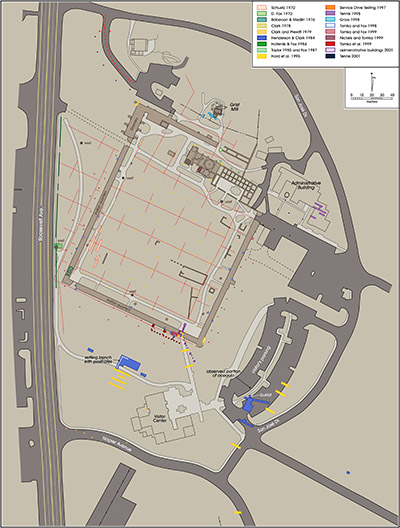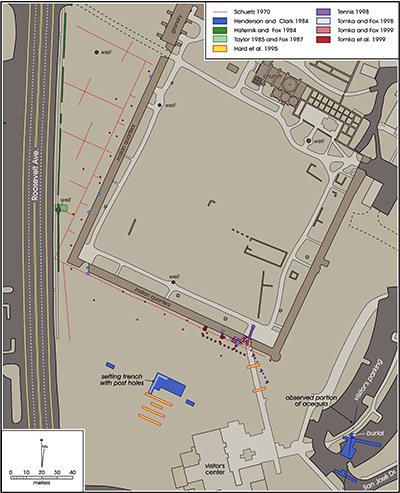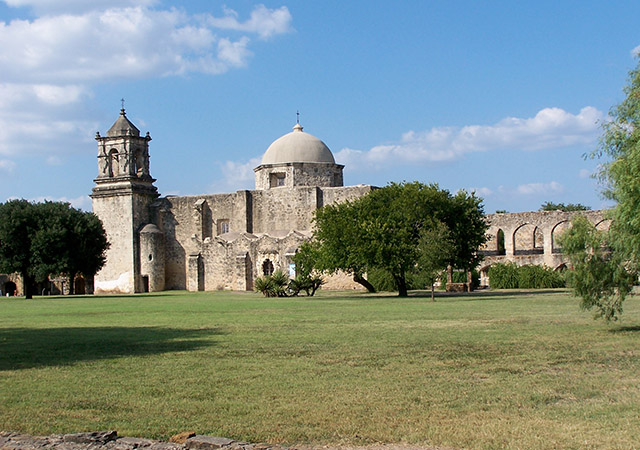Artifact Gallery
The artifact gallery contains images of lithics and artifacts recovered from Mission San José y San Miguel de Aguayo. Visit the Mission San José y San Miguel de Aguayo gallery to view those artifacts.
In the Beginning
Mission San José y San Miguel de Aguayo was the second mission established in San Antonio. It began in 1720 on the east bank of the San Antonio River approximately 3.5 miles south of Mission Valero. Mission San Antonio de Valero was the first of the San Antonio missions. Sometime between 1724 and 1727 Mission San José was relocated to the west bank of the river where it remained through 1739. It was moved to its present location approximately a half-mile from its second site in 1740. Mission San José was established by missionaries from the College of Zacatecas, under the direction of Fr. Antonio Margil, the presidente of the Zacatecan missionaries, and was named after St. Joseph and the Marqués de Aguayo, the governor of Coahuila and Texas.
The Native Groups
The friars of Mission San Juan Capistrano attempted to evangelize the local population occupying present-day San Antonio, which during the early sixteenth century included primarily Coahuiltecan-speaking peoples. Specifically these were the Borrado, Camasuqua, Chayopine, Guanbraunta-Aiaguia, Malaquita, Orejone, Pacao, Pajalat, Pamoque, Pana, Pasnacan, Peana, Peguique, Pitalac, Sarapjon, Tacame, Taguaguan, Tilijae, Tinapihuaya, Venado, and Viayan (Campbell 1988:90, Carlson 1994:77, Mitchell 1980). Members of the individual tribes resided at the mission periodically during the mission’s history. They were not all consistently present or present in large numbers. They brought with them knowledge and skills of ceramic and lithic technologies as exhibited in their material cultures that today provides a rich archaeological record of the brief co-existence of Native Americans and Spanish Colonists.
The mission was originally founded for members of the Pampopa, Sulujam, and Pastia Indians who were living at Mission Valero but had requested their own mission (Habig 1997:83). Between its founding and its partial secularization in 1794, members of several other named groups joined the mission in small numbers. A total of 21 resident group names are mentioned in various documents, although given that the early registers of Mission San José have been lost, it is likely that the number was even higher (Campbell and Campbell 1996; Schuetz 1980).
The Mission Compound
While the first structures built at the final site were temporary jacales (log structures), by 1749, during his visit to the mission, Fr. Ciprian reported that a large adobe church, as well as a granary, friary, and Indian quarters of stone had already been completed. The still-standing stone church was begun in 1768 and completed in 1782. By 1789, the mission compound was surrounded by walls formed by the Indian quarters, two bastions guarded its southeast and northwest corners, and entry could be gained through six gates (Habig 1997:116-117, 306). A flour mill was added to the mission between 1790 and 1794 along the irrigation ditch that flowed outside of the north wall (drawing from Clark 1978).
Population Trends
The population of the mission was in constant flux, in part influenced by the timing of epidemics and fluctuations in available resources in and away from the missions. In 1721, at the first location of Mission San José, the Indian population reached 240 individuals prior to its relocation. In 1739, following the smallpox/measles epidemic that caused the second move, the Indian population declined to 49 persons. Similarly, in 1783, following a second smallpox epidemic, the population declined from 275 to 128 individuals. At the time the mission was partially secularized, the lands, domesticated animals, and various tools were distributed among 93 Indians that still resided there. By 1797, there were only eight Indians still living at the mission.
By the early nineteenth century, Spaniards also began settling near the mission. In 1804, the population of Mission San José consisted of 57 Indians and 36 Spaniards. In 1809, San José had a population of 70 individuals, 55 of whom were Indians and 15 were Spaniards. Finally, in 1815, the population of San José was 109 persons with 49 Indians and 60 Spaniards (Habig 1997:103). Only some of the fields that were given to the Indians were irrigated and the Indians were said to be practically destitute (Habig 1997:107). The mission was fully secularized in 1824.
History of Archaeological Projects
 The earliest restoration efforts undertaken at Mission San Jose were initiated by the archbishop of the San Antonio Diocese in 1917. The work focused on clearing the entrance of the church and sacristy. Some work also was undertaken inside the church.
The earliest restoration efforts undertaken at Mission San Jose were initiated by the archbishop of the San Antonio Diocese in 1917. The work focused on clearing the entrance of the church and sacristy. Some work also was undertaken inside the church.
Large-scale subsurface work in association with the reconstruction and restoration of portions of the mission began in 1932 sponsored by the San Antonio Conservation Society and undertaken by the Civil Works Administration under the direction of local architect Harvey P. Smith, Sr. These efforts continued into 1937 and led to the restoration of the granary, the north wall of the mission, several Indian quarters, and the clearing of the acequia. While no systematic archaeological investigations were conducted inassociation with the rebuilding project, large quantities of artifacts were collected during the re-excavation of the colonial wall foundations and several Indian quarters floors. The sacks of ceramics and other artifacts were never curated and their whereabouts are not known.
Between 1968 and the present, at least 18 formal and systematic archaeological investigations have been carried out within the bounds of the mission and immediately outside of its walls. Some of these were prompted by improvements to the mission grounds (Clark and Prewitt 1979; Durst 1999; D. Fox 1970; Hafernik and Fox 1984; Tennis 2001; Tomka and Fox 1998, 1999). Other projects represented systematic attempts at defining the nature of the archaeological deposits found in distinct portions of the mission compound or areas immediately outside of its walls (Bradford and Traylor 1981; Clark 1978; A. Fox 1987; Fox and Cox 1991; Hard et al. 1995; Henderson and Clark 1984; Nickels and Fox 1999; Schuetz 1970; Tennis 1998; Tomka et al. 1999). In combination, the salvage and systematic testing projects have resulted in a comprehensive sampling of all portions of the compound, including the courtyard, areas outside of the walls, and the nearby acequia. A small number of the rooms within the Indian Quarters also have been investigated.


Accessions and Content of Collections
The Center’s curation facility holds materials from 34 accessions associated with investigations at Mission San José. The accessions include materials recovered during surface collections and various levels of testing and data recovery. The earliest of the accessions consists of materials obtained in 1933 while the latest represents collections associated with construction monitoring in 2006 (detailed table of accession). Some of the accessions contain artifact collections and project-related documentation while others consist only of documentation. Collections accessioned prior to 1983 are state Held-In-Trust (HIT) materials while those accessioned after 1983, when the San Antonio Missions National Historical Park (SAMNHP) became the managers of the site (not including the church), are under federal control.
More than half (20 of 34) of the archaeological investigations at the mission were carried out by the Center. Although the remainder was conducted by a variety of other agencies, under the sponsorship of the SAMNHP, all of the collections from projects conducted at the site are curated at CAR. Twenty-four of the 34 accessions contain artifacts, the remainder consists only of project-related documentation.
The total number of artifacts exceeds 123,000 specimens. In its electronic curation database, the CAR has detailed artifact-class level inventories for more than 44 percent (n=54,609) of these collections (detailed table of artifact classes by accession). Hard copy artifact-class level inventories of the remaining collections (n=68,591) exist in reports published on the respective investigations. Native-made materials consist of chipped and ground stone artifacts and undecorated ceramics. Gun flints and arrow point made of glass and copper reflect the influence of recycled materials on native technologies while the other artifacts represent the continuation of prehistoric technological traditions and their adaptation to the manufacture of artifacts used by Spanish soldiers (i.e., gun flints). Spanish-made items consist primarily of tin and lead glazed ceramics while post-secularization historic artifacts include European ceramics and a variety of glass and metal artifacts. A large portion of the animal bones recovered from the site date to the Colonial Period although saw-cut bone dating to sometime after the mid-nineteenth century also is common. One of the accessions (#661) derives from the excavation of a well that contained strictly late 19th and early 20th century artifacts. These artifacts document the ethnic and social history of the neighborhood that flourished near the mission following secularization.
The projects carried out at the mission document the history of reconstruction and restoration efforts, facilities improvements, and systematic archaeological investigations. As such, they reflect the history of conservation efforts within the city, first through the San Antonio Conservation Society, and later by the San Antonio Missions National Historical Park.
These collections of artifacts can be grouped into the following broad categories: chipped lithics, ground stone, ceramics, and metal artifacts. For an eΩxample of each type of artifact, visit the artifact galleries below.


